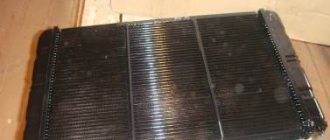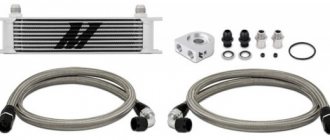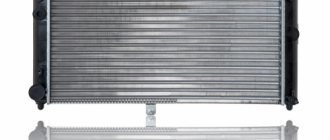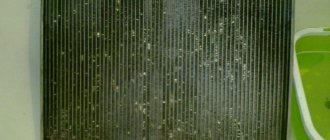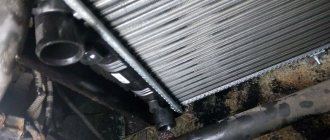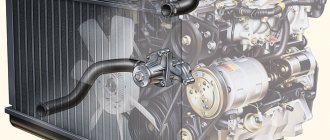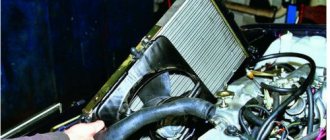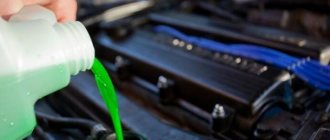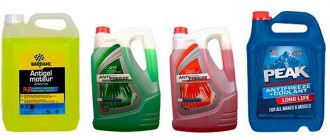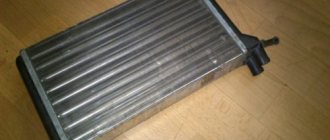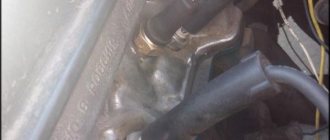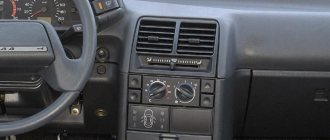Radiator repair in a car often has to be done in cases where problems arise in the engine cooling system. As everyone knows, the radiator is the most important part in the cooling system of a car. It is here that the antifreeze breaks up with excess heat, creating an optimal operating temperature for the engine.
One of the main symptoms of a faulty car radiator is engine overheating. It is impossible to postpone the solution to this problem, since overheating increases the wear of engine parts and in the future there is a high probability of the power unit failing, which will require significant cash injections for its repair.
At the bottom of the page, watch a video on how to solder a cooling radiator yourself at home.
Below we will describe the main ways to repair car cooling radiators with your own hands, and what to do if the radiator suddenly leaks.
Is repair always possible?
A radiator leak detected early is easier to repair because the cause of the failure is a small crack. A defect identified in time is easier to eliminate, and the restored device will last for many more years.
To reinforce the adhesive layer, it is possible to use simple plastic mesh Source Samsvar.ru
How to seal a car radiator
Now let's talk about how to seal the radiator and what glue is best suited for this. Thus, one of the best options is considered to be the two-component adhesive 3M DP 8805. The basis of its composition is acrylic, which makes it possible to use the composition for working with difficult-to-glue materials:
- the main advantages of such glue are the ability to create a sufficiently strong and reliable seam that will not lose its original shape when exposed to high temperatures;
- The disadvantage is the rather high cost.
Special welding adhesives are also a good option. They are designed for quick and, most importantly, effective elimination of defects on plastic surfaces. Adhesive joints after such compositions withstand not only high but also low temperatures. In addition, they are not afraid of high atmospheric pressure.
To avoid making a mistake in your choice, we recommend purchasing the required adhesive from a certified automotive store.
Basic methods for eliminating leaks
Before starting repair work, you should decide on the restoration method. Most often, damage is eliminated using:
- gluing. This method is chosen to eliminate minor cracks. To successfully solve the problem, pay attention to the composition of the glue: the substance must be selected according to the material of which the radiator body is made;
- cold welding. The adhesive mass contains epoxy resin and additives in the form of iron and other compounds. Repairs using cold welding occur efficiently and quickly. Despite the ease of use, a leak can be eliminated in a short time by forming a reliable seam at the crack site.
Assessing the extent of radiator damage
It is customary to install the radiator itself in the engine compartment, or rather in its front part. This is how it is possible to create the effect of blowing with a counter flow of air while the vehicle is moving. The disadvantage of a car heat exchanger is its fragility. This device is often called the most vulnerable part of any car.
Even if the slightest impact occurs, the likelihood of mechanical damage to the spare part in question is quite high. Heat exchangers whose water tanks are made of plastic break down especially often. Therefore, when deciding how to repair a radiator, you need to focus primarily on your capabilities. Carefully study all the methods presented above and try to figure out which method will be the most convenient and simplest from a practical point of view.
It is also important to first assess the extent of the damage. If it is strong enough, it is recommended to focus on direct soldering
This way you can deal with really large cracks that cannot be fixed with ordinary glue. If the crack is not the largest, cold welding type putty is quite suitable. Glue will be the optimal solution for restoring small cracks.
If you are not sure that you know how to seal a car’s cooling system, it is better to focus on repairing the system at a car service center. In addition, you won’t have to spend too much money on restoration work carried out by a mechanic, because the process itself is not considered difficult.
This is interesting: Unusual use of a glue gun - what can be made from hot glue
Application of glue
Only two-component adhesive mixtures are suitable for repairing a plastic radiator. They cope well with situations where the crack in the radiator is large enough or it is not possible to connect the parts of the case due to a lack of small fragments. If a small crack is being repaired, simply mix the glue components and apply it to the crack in two layers.
In some cases, a crack appears in a hard-to-reach place. In this case, the sealant is applied along the entire length of the radiator Source Chebo.pro
In what cases is soldering an aluminum radiator pointless?
Whether it is possible to solder an aluminum car radiator with a soldering iron yourself depends on the nature and extent of its damage. If the defects are significant or located in inconvenient places, restorative repairs are impractical and it is better to replace the damaged part with a new one. We can list the following cases when it is impossible to solder an aluminum radiator:
- Major damage to the heater radiator . It is undesirable to solder a stove radiator with large defects due to the complexity of dismantling and the economic impracticality of repairs. It is better to immediately replace the part with a new one.
- Deformation of aluminum at the junction with plastic . Neither solder nor adhesives provide the required degree of reliability for repairs, so the risk of repeated leakage is high.
- Solder break after repair . If even a high-quality solder breaks, a leak appears again - this means that the necessary adhesion is not provided and the repair connection cannot withstand pressure. This is especially true for oil radiators and air conditioning condensers, which operate under relatively high pressures.
Significant contamination of the radiator is almost impossible to clean
- Significantly clogged radiator . A heavily contaminated and clogged radiator loses efficiency, and if it cannot be washed, then there is no point in repairing it.
- Defects in the thickness of the honeycomb . If the tube leaks not from the edge, but inside the honeycomb, wear and fatigue of the metal is most likely occurring. Since in such a situation it is difficult to get to the crack for repair, part of the honeycomb will have to be removed, which will negatively affect the cooling efficiency, and the risk of repeated rupture is high.
- Rupture at the junction of the tube and the tank . Cracks and breaks along the seam, in the area where the tube passes into the tank, are difficult to solder due to the difficulty of access, and the loads there are high and there is a high risk of solder delamination.
If one tube has significant defects that do not allow it to be sealed normally, the tube can be completely excluded from the circuit. To do this, you need to carefully cut it at the transition points to the tanks (bottom and top or left and right), and then solder the resulting gaps, as shown in the video.
Excluding one tube from the circuit will slightly reduce the overall efficiency of the radiator (proportional to the number of tubes: if there are 20 - by about 5%, if 10 - by 10%), but you can achieve high-quality filling of the gap with solder and reliable sealing.
Tubes can only be removed from radiators with parallel connections. If the tubes are connected in series (according to the coil principle), then after such a repair the radiator will not work, since the liquid will not be able to flow through the circuit.
Cold welding
This epoxy resin-based adhesive is excellent for repairing any plastic parts - just apply the adhesive and wait until it dries completely. Cold welding can also be used as an additional protective layer over a patch of regular two-part adhesive.
To eliminate a leak at the junction of the pipe, it is best to use cold welding Source B2b-instrument.ru
Is it possible to solder an aluminum radiator yourself?
To solder an aluminum car radiator with your own hands, you will need:
- powerful (from 90 W) soldering iron or gas burner;
- alcohol or hydrocarbon solvent (anti-silicon, white spirit, purified gasoline, etc.) for degreasing;
- solder (preferably in a flux rod;
- flux (if the solder is not flux in the rod);
- metal brush or sandpaper.
Having prepared all the tools, you need to drain the coolant, dismantle the radiator, place it on the table and begin work:
How to solder an aluminum radiator - filalu 1192 nc solder: video
- Clean the defect area with a metal brush or sandpaper to remove dirt and thick oxides.
- Treat the repair area with a degreaser.
- Turn on the heating of the soldering iron or prepare the gas burner.
- Liberally treat the repair area with flux so that it covers it and blocks the access of oxygen.*
- Warm up the repair area with a lit torch or soldering iron.
- Solder the hole by applying solder under the torch or to the soldering iron tip.
- After soldering is completed, check the radiator by filling it with water and applying pressure (no more than 8–10 atm) with a compressor or pump.
*If you use aluminum solder with flux (like Filalu 1192 NC), it is not necessary to pre-apply flux in the soldering area. When using acid fluxes, their residues after repairs must be washed off using flux remover or an aqueous soda solution of 5–10%.
To prevent the formation of an oxide layer, galvanic copper plating of the repaired surface can be used. Since copper is tinned much easier than aluminum, its thin film will allow for better solder adhesion. To solder a copper-plated car radiator you will need:
- copper sulfate (copper sulfate);
- a current source with a voltage from 1.5–2 to 12 V with copper wires connected to it;
- plasticine;
- degreaser;
- metal brush or sandpaper;
- solder;
- flux;
- powerful soldering iron.
Soldering of an automobile aluminum radiator with copper plating is carried out in the following order:
How to solder an aluminum car radiator with copper plating: video
- The repair area is cleaned of oxides and degreased.
- A flange is formed around the plasticine hole to prevent the anodizing solution from leaking out. An aqueous solution of copper sulfate 20% is poured into the flange.
- The negative terminal of the current source is connected to the radiator ground. The positive terminal is immersed in the thickness of the vitriol solution. However, it should not touch the mass.
- Current is supplied to the wires; the duration of the supply is about 2–5 minutes, depending on the area of copper plating and the strength of the current.
- After the formation of a copper coating on the surface of the copper sulfate is drained, the plasticine is removed and the surface is degreased. The copper layer is very thin, so you shouldn’t rub it too hard!
- The soldering iron is turned on to warm up and at the same time the repair area is covered with flux.
- After heating the soldering iron, its tip warms up the repair area and solder is supplied to it.
When using chemical soldering (cold welding, metal glue, epoxy or PE resin), the procedure is as follows:
- Clean the repair area from dirt and dense oxides.
- Degrease the surface to which the repair compound will be applied.
- Using a brush or another method (depending on the consistency of the composition), apply the adhesive composition to the hole. If the hole is large, you need to cut a patch from reinforcing fabric or mesh, soak it with glue and apply it to the hole. After this, as soon as the resin begins to set (usually about 5 minutes), apply another layer with a brush and repeat the action 3-5 times.
- Wait until the glue has completely hardened and test it by filling the radiator with water under pressure from the water supply or pouring water from any container and creating pressure with a compressor.
The nuances of soldering various radiators
All radiators (main, oil, heater, air conditioner) have a single design principle and represent a grid of tubes connected to cooling fins. But they work with different substances, under different conditions, so they differ in design nuances and require a different approach to repair:
- The main antifreeze radiator has relatively thin flat tubes, but a large number of thin sheet aluminum lamellas sandwiched between them. The normal operating pressure for which it is designed is 1–2 atm, and the temperature is up to 110–120 °C. Since the tubes are thin, it is equally convenient to solder them with solder and a torch or soldering iron, or chemically, without reinforcement.
- The stove radiator operates under conditions similar to the main one (the same liquid, the same pressure and temperature), but it is smaller, therefore, for better heat transfer, it has a larger cross-section of channels and is more densely penetrated with honeycombs. Since it is more difficult to solder an aluminum stove radiator due to the density of the arrangement, but it is also cheaper, it makes sense to repair only small and easily accessible defects.
- Oil radiators are designed to cool viscous liquids, so they have a larger channel cross-section. Temperatures are also higher, by about 10–20 °C, and the operating pressure reaches 5 atm. at high speeds. Because of this, it is advisable to solder such radiators with high-temperature (from 300 °C) solder, with high-quality flux, or cook with argon.
- The air conditioner radiator is similar in design to the main radiator, but is not designed for high temperatures of more than 100 degrees, while maintaining a pressure of up to 3 atm. and higher. Therefore, it makes sense to solder only small defects, or use welding.
- The intercooler works with air at ambient temperature, and does not encounter high pressures from the inside, but since it must pass large volumes of air, it has a large cross-section of channels. Minor damage to these channels is soldered in the same way as on the main radiators of the engine cooling system. If there is a large defect, then before soldering the aluminum intercooler radiator, it may be necessary to remove part of the honeycomb fins for good access to the hole.
Internal radiator repair using chemicals
There are special compounds on sale that can be used to restore the tightness of the radiator without extra effort. This chemical is a powder poured inside the radiator. Under the influence of water and high temperature, the particles of the composition swell and seal minor cracks in the body. In auto shops, this product is known as “powdered radiator restorer.”
Appearance of a sealing patch made from two-component adhesive Source Drive2.ru
How to fix a leak in a radiator with sealant
The sealant is a special composition for sealing cracks and holes in the cooling system and in particular in the radiator.
There are several types of sealing agents:
- Powder. We fill the radiator when a coolant leak occurs. The simplest and most popular option among owners of domestically produced cars is mustard. Some car enthusiasts even use tobacco and other equally exotic substances for these purposes.
- Advantages. The advantages of dry products include low cost and the ability to eliminate small defects (up to 1 mm).
- Flaws. There is also a significant drawback, which is that not only leakage points are clogged, but also the radiator channels in the interior cooling and heating system.
- Liquid preparations. Preparations of this type are based on polymers with the addition of small metal particles. As a rule, such products are used to eliminate leaks in the engine block, but also partially in radiators. The operating principle is as follows: polymers cling to small roughnesses and sharp edges and envelop them.
- Advantages. The advantages of this option include the fact that the sealant is constantly present in the coolant and when it is replaced, it is removed from the cooling system.
- Flaw. Only small holes (no more than 1 mm) can be sealed with a polymer preparation;
- Modern polymer-type products. Products of this type contain special fibers. A striking example of such a substance is the sealant for radiators LAVR STOP LEAK. Thanks to the fibers, the adhesion of the particles of the product between themselves and the edges of cracks improves.
- Advantages. The main advantage of this option is that in a few minutes you can seal a hole up to 2 mm.
- Flaws. High price.
Sealant for car radiator - application
The main mistake of most car enthusiasts is that they do not know the main function of the seal. And it is simple - eliminating coolant leaks during temporary use. Therefore, it is recommended to use a sealant only in cases where it is not possible to eliminate the leak in stationary conditions or in the garage.
If a sealant was used to eliminate the cause of the leak, then, if possible, drain the coolant, flush the system and carry out a full repair of the radiator.
Driver actions when using sealing agents:
- A temperature sensor can indicate a leak from the radiator while driving. If the car is parked, then a puddle of coolant can tell us that it is necessary to check its level.
- If such a problem does arise, then turn off the engine, wait until the coolant cools down and proceed to inspect the damage. If the liquid still continues to flow, install a container under this place to collect it.
- Remember! Do not open the radiator cap of a car while the engine is running or hot, as this can cause serious burns.
- If you have a powder or liquid product on hand, then place it in the radiator according to the instructions.
Next, we start the engine for a few minutes, turn it off, and after a while we check again for leaks with the unit running. If the leak is small and the sealant was used in accordance with its instructions, then the coolant should no longer leak. In cases where the defect could not be eliminated, this may indicate to us that the hole is large. In this case, soldering is no longer necessary.
How to choose the right sealant?
To make the choice easier, a summary table with two characteristics will help: the time of clogging of holes of different diameters and the level of deposits. To evaluate the last parameter, we used the mass of the thermostat before and after applying the additive. Such testing of sealants was carried out at the Department of Internal Combustion Engines of St. Petersburg Polytechnic University.
Table
The table shows that sealants cope with microcracks successfully, even large holes are blocked within 2-10 minutes.
How to find a crack or faulty radiator
When the crack is very small, you can detect the location of the antifreeze leak with a simple inspection to determine the source of the leaks. Severe damage is also easily detected by eye.
If the initial inspection fails to identify the location of the leak, experienced technicians do the following:
If the leak is very small, it is better to additionally mark it with a marker. After this, remove the rags and drain the water. All that remains is to decide on the repair method.
The simplest ways
First, it’s worth deciding on the scale of the tragedy.
. It is necessary to check all the pipes and the radiator itself in order to draw any conclusions. If the leak is minor, then one magical remedy called a chicken egg can help get rid of it for a while. Yes, yes, this is what saves many on the road. All you need to do is go to the nearest grocery store and buy this miracle product.
The chicken egg must be broken and its contents poured into the radiator. The leak will disappear in an incredible way. In fact, there is no magic in this. Everything is connected with the structure of the egg, which envelops the walls of the cooling radiator. This method is suitable if trouble happens on the way, but you cannot fully rely on this method.
Another simple way is to use sealant
. Of course, we are talking about a specialized version for cars. Here it is also worth talking about minor leaks, the diameter of which does not exceed 1-2 square mm. All you need to do is pour the contents of the jar into the radiator. the substance in it will clog the hole for a long time.
However, do not delude yourself, because such sealants often have a negative effect on the car. Over time, they can simply clog the cooling system. This is unacceptable, therefore, after using them, it is imperative to use various methods of cleaning the radiator in order to completely remove the substance from it.
The cooling radiator is leaking, what to do video
Many people think about the question, what to do if the cooling radiator leaks.
This trouble occurs especially often while on the road. In this case, many simply panic, because even a minor leak can have a detrimental effect on the performance of the entire car as a whole. Sometimes situations arise when coolant gets into the fuel injection system, and this can cause serious problems, including engine failure.
. If you notice that the cooling radiator is leaking, you need to fix this problem as quickly as possible. This is what we will talk about today.
What to do if the cooling radiator leaks while on the road? This question is most often asked by people to professionals. Let's first consider the most primitive methods of eliminating leaks.
